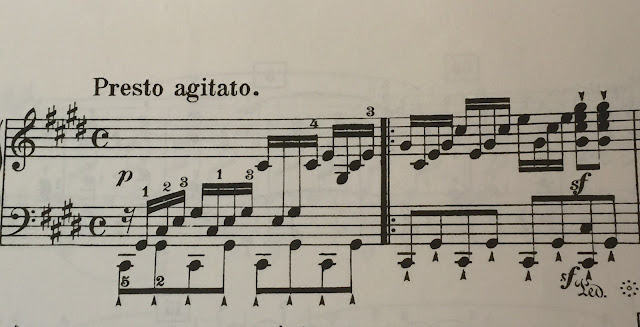My student forwarded me a link to an originalist pianist who is caught up in a study of Beethoven's intended tempos for the piano sonatas. He argue's that in the final movement of the Moonlight Sonata Czerny's metronome marking (yes, Czerny's) of a half-note equals 92 really means a quarter-note equals 92. He gives as evidence a passage toward the end where thirty-second notes seem to him to require slowing the tempo to one-half. He compares his version with the extravagant pianist, Valentina Lisitsa. It's a stark contrast. His performance at this tempo sounds to me like an andante amiable, not a presto agitato.
 |
| Beethoven Op.27, No. 2, 3rd Movmt. |
 |
| Beethoven Op. 27, No. 2, 3rd Movmt, MM 62-63 |
point. There has been a great deal of research regarding B's tempos, so I won't burden my comments here with much of that. Definitive conclusions are difficult to come by, anyway. (One good resource is Beethoven on Beethoven: Playing the Piano Music His Way by William S. Newman, pp. 83-120.). We have only Czerny and Moscheles (who differ) for metronome references in the piano sonatas (except Op. 106), the provenance and meaning of which have remained unclear. This has led to considerable confusion. On what are their numbers based, anyway? On Beethoven's performances, which according to contemporary accounts varied considerably?
Though B. set out to add metronome marks to his works retroactively, he didn't get to the piano sonatas. He gave up entirely at the end, leaving the last six string quartets and the last three piano sonatas unmarked, giving rise to the speculation that he lost faith in the usefulness of the metronome. (There is quite a bit of back and forth on this in letters to publishers and colleagues.)
This is not really this pianist's point, though. In my performances, I take more seriously the composers written instructions regarding a work's desired affect. In this case Presto agitato is the main clue. This pianist's choice of tempo achieves neither. And it should be mentioned that the Op. 27, No. 2, was written for the composer to perform at a time when his reputation was that of a virtuoso.
Also, the comment regarding Lisitsa's
 |
| Valentina Lisitsa |
You'll have to forgive me if I keep returning
 |
| Carl Philip Emmanuel Bach |


No comments:
Post a Comment